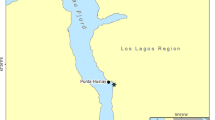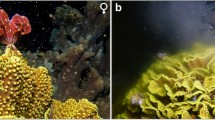Abstract
The present study investigated the sexual pattern of the yellow-tailed dascyllus, Dascyllus flavicaudus (Randall and Allen), through histological examination of the process of gonadal differentiation and maturation and through male-removal experiments in the laboratory. The study was conducted in Moorea, French Polynesia (17°32′S; 149°50′W), from 31 December 1994 to 11 March 1995. For gonadal histology, two populations were sampled, one consisting of large aggregations (n=54) and the other consisting of small- to medium-sized groups around isolated corals (n=55). An additional small sample (n=21) was also collected from a population that consisted of small groups around isolated corals. After an initially undifferentiated state, gonads of D. flavicaudus developed an ovarian lumen, followed by oocytes in the primary growth stage. From this ovarian state or from more developed ovaries with cortical-alveolus stage oocytes, some gonads developed into testes through degeneration of oocytes and development of spermatogenic tissue. In all three populations, spermatogenic tissue developed only in gonads that contained pre-vitellogenic oocytes (termed as mixed stage 1–2 gonads). The two main populations did not differ in their expression of sex change despite differences in their social organization. In both populations, size of individuals with mixed stage 1–2 gonads overlapped mainly with the size range of immature females, which suggests that functional female-to-male sex change was rare. The hypothesis that D. flavicaudus is primarily gonochoristic is further supported by removal experiments in laboratory groups, in which removal of a dominant male(s) failed to induce sex change in any of the high-ranking females. Yet, in all three field populations, some fish with mixed stage 1–2 gonads were found within the size ranges of mature females, which indicates possible occurrences of functional sex change. These conflicting results indicate that it may be premature to draw any definitive conclusions about the sexual pattern of D. flavicaudus.




Similar content being viewed by others
References
Allen GR (1991) Damselfishes of the world. Mergus, Melle, Germany
Asoh K (2003) Gonadal development and infrequent sex change in a population of the humbug damselfish, Dascyllus aruanus, in continuous coral-cover habitat. Mar Biol 142:1207–1218
Asoh K, Kasuya M (2002) Gonadal development and mode of sexuality in a coral-reef damselfish, Dascyllus trimaculatus. J Zool (Lond) 256:301–310
Asoh K, Yoshikawa T (2003) Gonadal development and an indication of functional protogyny in the Indian damselfish, Dascyllus carneus. J Zool (Lond) 260:23–39
Asoh K, Yoshikawa T, Kasuya M (2001) Gonadal development and non-functional protogyny in a coral reef damselfish, Dascyllus albisella Gill. J Fish Biol 58:1601–1616
Atz JW (1964) Intersexuality in fishes. In: Armstrong CN, Marshall AJ (eds) Intersexuality in vertebrates including man. Academic, New York, pp 145–232
Bernardi G, Crane NL (1999) Molecular phylogeny of the humbug damselfishes inferred from mtDNA sequences. J Fish Biol 54:1210–1217
Choat JH, Robertson DR (1975) Protogynous hermaphroditism in fishes of the family Scaridae. In: Reinboth R (ed) Intersexuality in the animal kingdom. Springer, Berlin New York Heidelberg, pp 263–283
Coates D (1982) Some observations on the sexuality of humbug damselfish, Dascyllus aruanus (Pisces, Pomacentridae) in the field. Z Tierpsychol 59:7–18
Cole KS (2002) Gonad morphology, sexual development, and colony composition in the obligate coral-dwelling damselfish Dascyllus aruanus. Mar Biol 140:151–163
Cole KS, Robertson DR (1988) Protogyny in the Caribbean reef goby, Coryphopterus personatus: gonad ontogeny and social influences on sex-change. Bull Mar Sci 42:317–333
Davies NB (1991) Mating systems. In: Krebs JR, Davies NB (eds) Behavioural ecology, an evolutionary approach, 3rd edn. Blackwell, Oxford, pp 263–294
Emlen ST, Oring LW (1977) Ecology, sexual selection, and the evolution of mating systems. Science 197:215–223
Fricke HW (1973) Okologie und Sozialverhalten des Korallenbarsches Dascyllus trimaculatus (Pisces, Pomacentridae). Z Tierpsychol 32:225–256
Fricke HW, Holzberg S (1974) Social units and hermaphroditism in a pomacentrid fish. Naturwissenschaften 61:367–368
Ghiselin MT (1969) The evolution of hermaphroditism among animals. Q Rev Biol 44:189–208
Godwin J (1995) Phylogenetic and habitat influences on mating system structure in the humbug damselfishes (Dascyllus, Pomacentridae). Bull Mar Sci 57:637–652
Gray P (1954) The microtomist’s formulary and guide. Blakiston, New York
Grier HJ (1981) Cellular organization of the testis and spermatogenesis in fishes. Am Zool 21:345–357
Grier HJ (1993) Comparative organization of Sertoli cells including the Sertoli cell barrier. In: Russell LD, Griswold MD (eds) The Sertoli cell. Cache River Press, Clearwater, Fla., pp 703–739
Grier HJ, Linton JR, Leatherland JF, de Vlaming VL (1980) Structural evidence for two different testicular types in teleost fishes. Am J Anat 159:331–345
Hattori A, Yanagisawa Y (1991) Sex change of the anemonefish Amphiprion clarkii in a habitat of high host density: a removal study (in Japanese with English summary). Jpn J Ecol 41:1–8
Kuwamura T, Nakashima Y (1998) New aspects of sex change among reef fishes: recent studies in Japan. Environ Biol Fishes 52:125–135
McCafferty S, Bermingham E, Quenouille B, Planes S, Hoelzer G, Asoh K (2002) Historical biogeography and molecular systematics of the Indo-Pacific genus Dascyllus (Teleostei: Pomacentridae). Mol Ecol 11:1377–1392
Nakamura M, Hourigan TF, Yamauchi K, Nagahama Y, Grau EG (1989) Histological and ultrastructural evidence for the role of gonadal steroid hormones in sex change in the protogynous wrasse Thalassoma duperrey. Environ Biol Fishes 24:117–136
Ochi H (1989) Mating behavior and sex change of the anemonefish, Amphiprion clarkii, in the temperate waters of southern Japan. Environ Biol Fishes 26:257–275
Randall HA, Allen GR (1977) A revision of the damselfish genus Dascyllus (Pomacentridae) with the description of a new species. Rec Aust Mus 31:349–385
Randall JE, Randall HA (2001) Dascyllus auripinnis, a new pomacentrid fish from atolls of the Central Pacific Ocean. Zool Stud 40:61–67
Reinboth R (1962) Morphologische und funktionelle Zweigeschlechtlichkeit bei marinen Teleostiern (Serranidae, Sparidae, Centracanthidae, Labridae). Zool Jahrb Abt Allg Zool Physiol Tiere 69[Suppl]:405–480
Reinboth R (1970) Intersexuality in fishes. Mem Soc Endocrinol 18:515–543
Robertson DR, Warner RR (1978) Sexual patterns in the labroid fishes of the western Caribbean. II. The parrotfishes (Scaridae). Smithson Contrib Zool 255:1–26
Ross RM (1990) The evolution of sex-change mechanisms in fishes. Environ Biol Fishes 29:81–93
Sadovy Y, Shapiro DY (1987) Criteria for the diagnosis of hermaphroditism in fishes. Copeia 1987:136–156
Schwarz AL, Smith CL (1990) Sex change in the damselfish Dascyllus reticulatus (Richardson) (Perciformes: Pomacentridae). Bull Mar Sci 46:790–798
Selman K, Wallace RA (1989) Cellular aspects of oocyte growth in teleosts. Zool Sci 6:211–231
Shapiro DY, Rasotto MB (1993) Sex differentiation and gonadal development in the diandric, protogynous wrasse, Thalassoma bifasciatum (Pisces, Labridae). J Zool (Lond) 230:231–245
Shpigel M, Fishelson L (1986) Behavior and physiology of coexistence in two species of Dascyllus (Pomacentridae, Teleostei). Environ Biol Fishes 17:253–265
Thresher RE (1984) Reproduction in reef fishes. T.F.H. Publications, Neptune City, N.J., USA
Vehrencamp SL, Bradbury JW (1984) Mating systems and ecology. In: Krebs JR, Davies NB (eds) Behavioural ecology, an evolutionary approach, 2nd edn. Sinauer, Sunderland, Mass., USA, pp 251–278
Wallace RA, Selman K (1981) Cellular and dynamic aspects of oocyte growth in teleosts. Am Zool 21:325–343
Warner RR (1975) The adaptive significance of sequential hermaphroditism in animals. Am Nat 109:61–82
Warner RR (1984) Mating behavior and hermaphroditism in coral reef fishes. Am Sci 72:128–136
Warner RR (1988a) Sex change in fishes: hypotheses, evidence, and objections. Environ Biol Fishes 22:81–90
Warner RR (1988b) Sex change and the size-advantage model. Trends Ecol Evol 3:133–136
Warner RR, Robertson DR (1978) Sexual patterns in the labroid fishes of the western Caribbean. I. The wrasses (Labridae). Smithson Contrib Zool 254:1–27
Warner RR, Robertson DR, Leigh EG Jr (1975) Sex change and sexual selection. Science 190:633–638
Yogo Y (1987) Hermaphroditism and evolutionary aspects of its occurrences in fishes (in Japanese). In: Nakazono A, Kuwamura T (eds) Sex change in fishes. Tokai University Press, Tokyo, pp 1–47
Acknowledgements
I deeply thank the researchers and staff of Antenne de Recherches de l’Ecole Pratique des Hautes Etudes à Moorea, R. Galzin, V. Dufour, J. Algret, Y. Chancerelle, A. Lo-Yat, and C.M. Lo, for their assistance and support in every aspect of the fieldwork, and those at Gump Station, University California, Berkeley, for the wet-lab access. Millions of thanks go to L.A. Privitera, T. Yoshikawa, and two anonymous referees for helpful discussions and the review of the manuscript, to M. Tamura for preparation of the picture plates, to M.C. Rigby for his company in many dives, and to M. Kasuya for help in histological processing. L.A. Privitera also went through an agony of grammatical corrections and editing. She demonstrated an astonishing talent in reading between the lines and provided many beautiful alternatives to my clumsy sentences. The field collection and laboratory processing parts of this study were supported by a fieldwork scholarship from the East–West Center, a Hawai‘i Audubon Society Research Grant, a Raney Award from the American Society of Ichthyologists and Herpetologists, a Sigma Xi Grants-in-Aid of Research Award, and an International Women’s Fishing Association Scholarship, and the Department of Zoology at the University of Hawai‘i. I was supported by the Department of Biology, Ochanomizu University, during slide analysis and writing of the manuscript. This research was approved by the Institutional Animal Care and Use Committee of the University of Hawai‘i.
Author information
Authors and Affiliations
Corresponding author
Additional information
Communicated by T. Ikeda, Hakodate
Rights and permissions
About this article
Cite this article
Asoh, K. Gonadal development in the coral reef damselfish Dascyllus flavicaudus from Moorea, French Polynesia. Marine Biology 146, 167–179 (2004). https://doi.org/10.1007/s00227-004-1414-7
Received:
Accepted:
Published:
Issue Date:
DOI: https://doi.org/10.1007/s00227-004-1414-7




